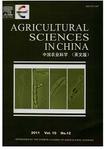Isolation and Characterization of Penicillium oxalicum ZHJ6 for Biodegradation of Methamidophos
Isolation and Characterization of Penicillium oxalicum ZHJ6 for Biodegradation of Methamidophos作者机构:College of Chemistry Beijing Normal University Beijing 100875 P.R.China Faculty of Food Science and Technology Agricultural University of Hebei Baoding 071001 P.R.China
出 版 物:《Agricultural Sciences in China》 (中国农业科学(英文版))
年 卷 期:2010年第9卷第5期
页 面:695-703页
核心收录:
学科分类:0710[理学-生物学] 090403[农学-农药学(可授农学、理学学位)] 07[理学] 09[农学] 0903[农学-农业资源与环境] 0904[农学-植物保护] 0901[农学-作物学] 0902[农学-园艺学] 0713[理学-生态学]
基 金:supported by the National Natural Science Foundation of China (20843004 20973026)
主 题:fungus biodegradation methamidophos Penicillium oxalicum pesticide remediation
摘 要:One methamidophos-degrading fungus strain, named as ZHJ6, was isolated from the soils contaminated with methamidophos. It was identified as Penicillium oxalicum based on its morphological characteristics and ITS rDNA gene sequence analysis. The effects of carbon source, nitrogen source and the concentration of methamidophos, temperature and pH on the degradation were investigated. The results showed that the strain could use glucose as carbon source and the methamidophos as sole nitrogen source. The degradation ratio of methamidophos, when the initial concentration was 1.0× 10^-3 mg mL^-1, could reach above 99.9% in 12 incubation days. The strain could use ethanol, glucose, fructose, sucrose, lactose, starch, and dextrin as its carbon and energy source to degrade the methamidophos. The favorable degrading condition of the strain ZHJ6 was in a mineral salt medium at pH 5.0 and 25℃ with 1% glucose, and further studies showed that the strain could degrade folimat, phoxim and glyphosate with glucose as carbon source, but could not degrade chlorpyrifos, phosdrin, trichlorphon, and dichlorvos.



